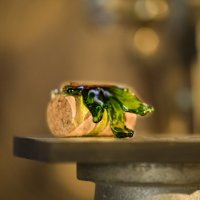Walking around the Ravin des Arcs
Discover a wild site as you descend from the Cévennes, in the Séranne massif. Close to the Pic Saint-Loup, the river Hérault has carved out wild gorges that are both green and mineral.
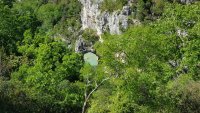
An exceptional wilderness site.
A small tributary of the Hérault river, the Lamalou, has carved out a narrow canyon in this garrigue landscape, bordered in places by high cliffs. In the bed of this temporary watercourse, the focal point of your walk, lie hidden wonders, culminating in a superb natural arch. Although the river is dry for much of the year, it can become a torrent at the first sign of rain.
Discover a wild site as you descend from the Cévennes, in the Séranne massif. Close to the Pic Saint-Loup, the river Hérault has carved out wild gorges that are both green and mineral. These gorges are a mosaic of grandiose, unspoilt landscapes, where you can marvel and recharge your batteries. Situated at the heart of the classified Grand Site de France Gorges de l'Hérault site, renewed in 2018, and two Natura 2000 sites, the Ravin des Arcs is recognised for its high environmental and landscape value. It is home to several threatened species.
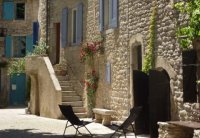
Departure point : Notre-Dame-de-Londres
At the bottom of the car park, go through the barrier (chicane). Take the stony path up above the stream.
Take the main path back down to the Garels wash-house.
This large concave masonry structure, judiciously placed in the landscape, is used to collect water for watering livestock.
Hard left...
Go left up the hillside, through sparse vegetation: look out for a small prickly shrub. This is the juniper known as cade. It is easily distinguished from its cousin, the common juniper, by the two white stripes on its spiny leaves. Further up, enter the oak undergrowth. Walk above the Lamalou gorges (follow the signs).
Cross the scree slopes: a view of the gorges, the Séranne mountain and the Roc Blanc in the distance, cross the Grabasses wood. The ground is blackened in places. These are the remains of old charcoal pits, evidence of past logging activities.

In the Ravin des Arcs
Descend to the right into the Ravin des Arcs (be careful, it is slippery). There is an uninterrupted view of the arch set against the cliff. This large arch is the result of the slow work of erosion on the rock. The winding path leads to the banks of the Lamalou.
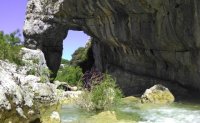
In the stream bed.
Descend the bed of the stream for around 150 m (crossing the watercourse is prohibited in the event of flooding). Cross over to the right bank, before the large pools of water. These shapes are still the result of erosion.
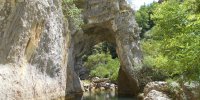
Under the oak tree...
Climb the steep, technical section along the rock faces. Follow the well-marked path, which winds through the Grand Bois de la Garde and its many tree species (the white oak is best recognised by the whitish down under its leaf).
From the top of the hill...
On the plateau, turn right onto the stony path. Gradually descend, facing the Pic Saint-Loup and the plaine de Londres, whose name is thought to come from the old local dialect "terrain dundras" meaning marshy, dried-up land.
Further down in the grassy meadow, continue straight ahead and cross the Lamalou again. Rejoin the path from the outward journey at the wash-house.

Reach the car park.
Follow the same route to the car park on the left.
Type : Pedestrian
Start: Notre-Dame-de-Londres
Length: 4 km
Time: 1h30
Difference in altitude: 248m

To find out more


